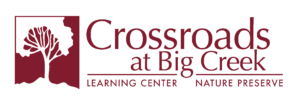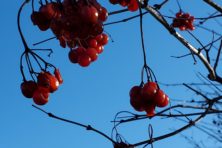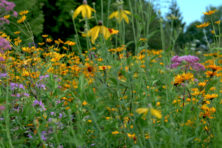Wild Ones: Evergreens Attract Winter Birds
- Share
- Tweet
- Pin
- Share

Most of us saw fewer birds during the early winter. The meager snowfalls of December and January did not cover the seed-bearing plants in the fields and in many gardens on the peninsula, so birds found plenty to eat without visiting bird feeders.

That changed with the heavy snow, but it didn’t increase feeder use for a friend of mine. She had been keeping a feeder filled with fresh, dry sunflower seed, yet she had not seen many birds.
Understand that during the winter, birds require food and protection. They need refuge: a place to which they can flee and hide when they sense a predator and a place to roost during the long winter nights. This cover must be relatively dry, out of the wind and out of sight.
According to the new Wild Ones publication Creating Your Own Native Garden Design, “Consider planting native trees and shrubs. These long-living plants provide structure and wildlife habitat.”
A website article from the Morton Arboretum explains further: “Emphasize native trees, shrubs and vines. Native plants and birds have evolved side by side over thousands of years. Native plants are more likely to provide the right mix, size and nutritional values that birds of our area require.
“By incorporating native habitats into our landscapes, we create natural corridors for birds to pass back and forth through their natural ranges. This is especially important in areas that have been impacted by development.”
Native plants are adapted to thrive in our local soils and tolerate our weather, and once they’re established, natives usually do not need fertilizer or extra watering.
For winter bird cover, it just makes sense to select evergreens because their foliage or dense needles act as a windbreak and umbrella for birds.
The Morton Arboretum also suggests “taking a cue from nature” by planting shrubs and trees in drifts or clusters: “If you look to nature, you’ll discover that in the wild, plants occur in groups.”
The Wild Ones publication has similar advice: “Plant densely! The more plants you use, the more design impact you will achieve and the less mulching and watering are needed.”
So to attract winter birds, start by planting at least one grouping of conifers: plants that provide windbreaks, shelter and nesting sites during the spring, summer and fall as well.
I recommend arborvitae (eastern white cedar) and white pine for bird cover in Door County. In my yard, birds seem to love my American yew, but deer love it even more. A previous owner planted my yew on the edge of a ridge, so deer have not (yet) decimated it. But if deer can reach a yew, it will be eaten.
Actually, arborvitae – and to a lesser degree, white pine – are favorite winter browse for deer, so all young evergreens should have adequate caging or fencing, at least for the first couple of winters.
More and more people are getting involved in feeding birds year-round, and with good reason: The bright colors and activity can brighten a dreary day. What most birdwatchers do not realize, however, is that they’re merely providing supplemental food. Those sweet, little birds are also consuming countless weed seeds and tens of thousands of insect eggs and larvae.
Therefore, winter birds provide significant benefits to a summer landscape, and our summer songbirds are more likely to flock to a landscape with native trees.
Coggin Heeringa is the president of Wild Ones of the Door Peninsula and the program director and naturalist at Crossroads at Big Creek in Sturgeon Bay.




